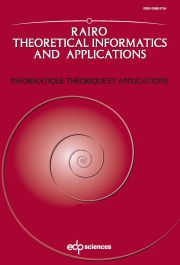Article contents
On the number of squares in partial words
Published online by Cambridge University Press: 11 February 2010
Abstract
The theorem of Fraenkel and Simpson states that the maximum number of distinct squares that a word w of length n can contain is less than 2n. This is based on the fact that no more than two squares can have their last occurrences starting at the same position. In this paper we show that the maximum number of the last occurrences of squares per position in a partial word containing one hole is 2k, where k is the size of the alphabet. Moreover, we prove that the number of distinct squares in a partial word with one hole and of length n is less than 4n, regardless of the size of the alphabet. For binary partial words, this upper bound can be reduced to 3n.
- Type
- Research Article
- Information
- RAIRO - Theoretical Informatics and Applications , Volume 44 , Issue 1: Special issue dedicated to the 12th "Journées Montoises d'Informatique Théorique" , January 2010 , pp. 125 - 138
- Copyright
- © EDP Sciences, 2010
References
- 11
- Cited by


